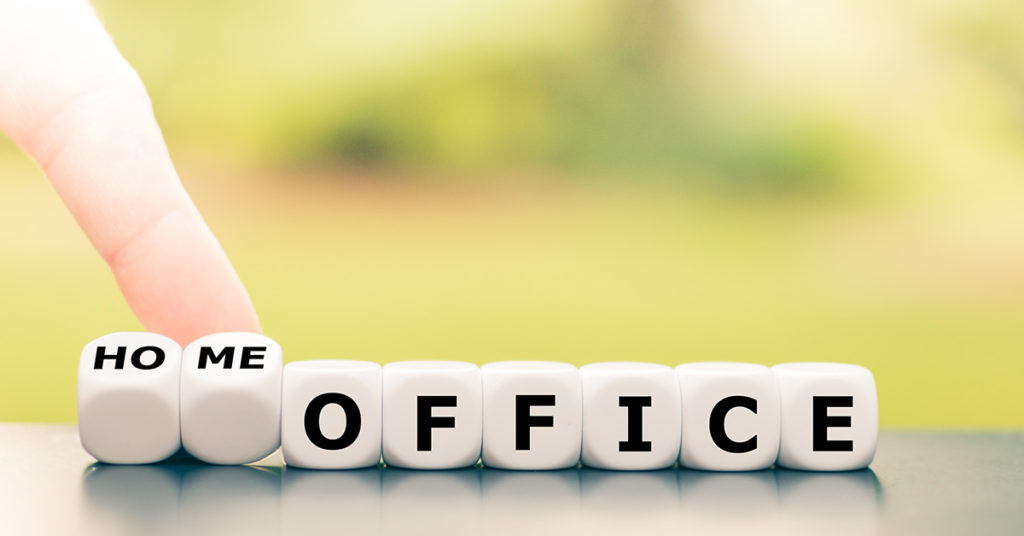Architecture affects our daily lives in many ways that we take for granted. It defines the environments in which we work rest and play.
So, when a life changing event like COVID causes dramatic disruption to our lifestyles, it will ultimately require an architectural response.
The necessity for a large proportion of the workforce to abandon their offices and transition rapidly to working from home (WFH) has resulted in many challenges, and surprising results.
Many are now embracing it as a permanent ideological shift that will change the structure of our urban environment, and the future design of the houses in which we live.
We’ve touched on the design implications of this in our recent article – Housing trends for living in a contagious world. With the knowledge garnered after 6 months of experiencing WFH, we can now analyse some of the pros and cons of this lifestyle shift.
The results will ultimately determine whether the WFH model becomes a permanent change and whether consequently we will need to adapt our future home designs to suit.
Lifestyle
The flexibility to work when and where we want without the restriction of set office hours is a definite benefit of the WFH change that many of us have enjoyed.
The time previously needed for personal grooming before presenting ourselves to weekday public exposure has decreased considerably, especially for those used to wearing makeup or working on their coiffure daily.

Combined with the time saving gained from no longer having to commute to and from an office, this can add hours of extra time to every working day, allowing more time for leisure, exercise, or other personal pursuits.
For most of us, the extra time spent in the home with family is also a bonus. For others, this may not be perceived as a benefit at all!
The choice of work attire in a WFH environment becomes much simpler when dress codes are not mandatory and dressing comfortably in casual attire every day is possible. Consequently, the need to wash and iron work clothes diminishes considerably, adding more credits to the leisure time bank.
Financial
Establishing a dedicated office(s) in homes that do not already incorporate suitable workspace may incur unexpected capital expenditure, and in some cases could trigger the need to purchase or design and build a new home.
We are also witnessing a trend of families migrating out of the dense city environments to regional areas. This is a direct consequence of the WFH experience as employers and their staff realise that working remotely from home is actually a viable option for many businesses, regardless of the home’s proximity to the office.
This is resulting in a dramatic slowing of the capital growth of housing in the major cities, and an increase in housing values in regional areas. Often this results in a cash positive outcome reducing mortgage stress and improving quality of life.
WFH also reduces day to day work related expenses associated with transport costs such as fuel, fares, and carparking. The number of household vehicles could also potentially be reduced as cars now sit idle in the home garage throughout the week.
Further work-related expenses associated with purchasing takeaway coffee, snacks or lunch are no longer incurred, and the cost of maintaining a wardrobe of specific work attire is redundant.
Depending on your individual circumstance, there are also potential tax advantages to WFH.
Without the daily commute to an office, the percentage of business use of your vehicle is likely to increase with the potential for higher tax deductions. You may also be able to claim a percentage of your house running costs as a tax-deductible business expense.
Health
The pace of life in the 21st Century has steadily increased over the years, with the work/life balance often out of kilter, resulting in increased stress and associated health issues.
Many of us have found that this enforced pause in our hectic schedules has come as a welcome relief, a time to reflect on what we truly value and consider most important in life.
Whilst working from home should allow for more lifestyle time, the lines between private and business life can easily become blurred when your home is also your office.
When work pressures arise, the temptation to slip straight from bed to desk, or to return to your computer after dinner can result in increased working hours. Weekdays and weekends can also become indistinguishable without the strictures of formal office working hours determining when to start and stop work.
Without the distractions and social interactions of an office environment, it is also easy to lose track of time and spend long periods of time sitting in front of your computer without standing and moving around. This extended sedentary behaviour is a well-known cause of health conditions including high blood pressure, high blood sugar and increased cholesterol levels.
This can be averted by taking regular breaks, assisted by devices such as smart watches that provide you with regular reminders to stand up and move around, or take time out to focus on some deep breathing.
It is also vital that the home office provides an ergonomic work environment.
Most commercial workspaces incorporate desks, chairs and computer monitor stands that promote good posture and a comfortable working environment. The home dining table or TV lounge are not designed specifically for work use, so will ultimately result in muscular ailments or cause other health issues if used over extended periods of time.
Diet can also be impacted positively or negatively in a WFH environment.
Having your own kitchen readily at hand allows you to prepare your own meals. For those with a disciplined diet, this can be a definite benefit. For others, the temptation to indulge in leftovers from last night’s roast dinner with a glass of wine at lunch may prove too great a temptation to resist!
The lack of social interaction with work colleagues in an office environment can also be detrimental mentally.
Whilst introverts generally thrive in a WFH environment and enjoy reduced contact with the office loudmouth or psychopathic boss, extroverts need daily contact with others to ensure their mental wellbeing. We are ultimately social beings, and the enforced isolation and need to WFH has seen a definite spike in reported cases of depression and suicide.
Conversely, the driver for this entire WFH scenario relates to the risk of catching COVID, a highly contagious disease from others in the workplace and public domain.
As a result of this enforced isolation from our work colleagues, the prevalence of flu cases over the winter period has dropped dramatically, as have other community spread conditions like the common cold.
Where to from here?
One certainty we can all accept is that life will not be returning to any kind of normal unless we find a successful vaccine to combat this disease.
Even if we do, the WFH genie has already escaped the bottle and is unlikely to be recaptured. Globally many companies are debating the merits of both work options in a post COVID world, and it is likely that a third hybrid option will develop in response involving some days of working in an office, and the balance of the week to WFH.
As Architects we will be watching closely how this plays out, and be ready to respond with innovative design solutions that enhance our ability to continue to work rest and play in fit for purpose buildings, whatever that might entail.
You might also be interested in...
The Most Popular Home Configurations in Australia in 2024
Discover 2024’s top Australian home configurations: bedrooms, bathrooms, and parking preferences. Explore how changing lifestyles shape popular house configurations nationwide.
Exploring Contemporary Applications of Brise Soleil
Contemporary applications of Brise Soleil combine functionality, aesthetics, and sustainability, making them a popular choice in various building designs worldwide.
